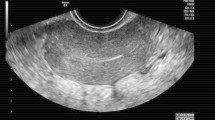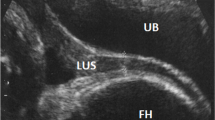Abstract
Objective
Ultrasonographic evaluation of the postpartum uterus to prevent retained placental tissue complications is still a matter of debate, and it is difficult to interpret its necessity on the basis of previous studies. We hypothesized that the application of uterotonics on the basis of regular postpartum ultrasound scanning of the uterus may reduce the number of unnecessary curettages in a large unselected population.
Methods
This was a cross-sectional observational study conducted among mothers (n = 6,028) delivering at two different (secondary and tertiary) hospitals to analyze the benefit of postpartum uterine ultrasound for clinical implications. Women delivering at the secondary care unit (n = 1,915) had no regular postpartum ultrasound scans in comparison to those delivering at the tertiary unit (n = 4,113). On regular ultrasound scans, morphological findings in the uterine cavity were recorded. Upon the presence of an intrauterine hyperechogenic mass larger than 2 cm in diameter, mothers received a single dose of uterotonics (methylergometrin 0.2 mg or oxytocin 5 IU) intramuscularly and control sonography after 24 h. In case of intrauterine mass persistence and serious postpartum hemorrhage women underwent a surgical intervention. The management was similar at the secondary unit, but ultrasound scans were provided only when there was a clinical finding. All patients were followed-up 6 weeks after labor.
Results
Women delivering at the secondary institution experienced a higher incidence of puerperal surgical interventions (1.51 vs. 0.87%) and lower agreement between sonography and histological findings (72.4 vs. 86.1%) compared with women delivering at the tertiary care unit, respectively (P < 0.05), where the general incidence of interventions was 1.10% after spontaneous and 0.19% after cesarean deliveries. In addition, trained sonographers reached only 13.9% false-positive ultrasound scans. Time-dependent regression analysis of uterine morphological involution variables showed a significant association between uterine length, width, uterine cavity and cervical channel mass, P < 0.0001, P < 0.01, P < 0.05, P < 0.05, respectively, and insignificant association between uterine cavity volume with an increased time period postpartum.
Conclusions
In this study, routine ultrasound evaluation of the uterus in the postpartum period with regular application of uterotonics decreased the rate of surgical interventions. We strongly advise the introduction of postpartum uterine scanning into obstetrical practice, most suitably provided around day 3 after delivery.






Similar content being viewed by others
References
Rome RM (1975) Secondary postpartum haemorrhage. Br J Obstet Gynaecol 82:289–292
Carlan SJ, Scott WT, Pollack R, Harris K (1997) Appearance of the uterus by ultrasound immediately after placental delivery with pathologic correlation. J Clin Ultrasound 25:301–308
Hoveyda F, MacKenzie IZ (2001) Secondary postpartum haemorrhage: incidence, morbidity and current management. Br J Obstet Gynecol 108:927–930
Ben-Baruch G, Menczer J, Shalev J, Romem Y, Serr DM (1980) Uterine perforation during curettage: perforation rates and postperforation management. Isr J Med Sci 16:821–824
Smid I, Bedo T (1978) Curettage during puerperium and its late consequences. Zentralbl Gynakol 100:916–920
Edwards A, Ellwood DA (2000) Ultrasonographic evaluation of the postpartum uterus. Ultrasound Obstet Gynecol 16:640–643
Shen O, Rabinowitz R, Eisenberg VH, Samueloff A (2003) Transabdominal sonography before uterine exploration as a predictor of retained placental fragments. J Ultrasound Med 22:561–564
Sokol ER, Casele H, Haney EI (2004) Ultrasound examination of the postpartum uterus: what is normal? J Matern Fetal Neonatal Med 15:95–99
Ben-Ami I, Schneider D, Maymon R, Vaknin Z, Herman A, Halperin R (2005) Sonographic versus clinical evaluation as predictors of residual trophoblastic tissue. Hum Reprod 20:1107–1111
Mulic-Lutvica A, Axelsson O (2006) Ultrasound finding of an echogenic mass in women with secondary postpartum hemorrhage is associated with retained placental tissue. Ultrasound Obstet Gynecol 28:312–319
Shaamash AH, Ahmed AG, Abdel Latef MM, Abdullah SA (2007) Routine postpartum ultrasonography in the prediction of puerperal uterine complications. Int J Gynaecol Obstet 98:93–99
Hertzberg BS, Bowie JD (1991) Ultrasound of the postpartum uterus: prediction of retained placental tissue. J Ultrasound Med 10:451–456
Deans R, Dietz HP (2006) Ultrasound of the post-partum uterus. Aust N Z J Obstet Gynaecol 46:345–349
Mulic-Lutvica A, Axelsson O (2007) Postpartum ultrasound in women with postpartum endometritis, after cesarean section and after manual evacuation of the placenta. Acta Obstet Gynecol Scand 86:210–217
Wachsberg RH, Kurtz AB, Levine CD, Solomon P, Wapner RJ (1994) Real-time ultrasonographic analysis of the normal postpartum uterus: technique, variability, and measurements. J Ultrasound Med 13:215–221
Robinson HP (1972) Sonar in the puerperium: a means of diagnosing retained products of conception. Scott Med J 17:364–366
Malvern J, Campbell S, May P (1973) Ultrasonic scanning of the puerperal uterus following secondary postpartum haemorrhage. J Obstet Gynaecol Br Commonw 80:320–324
Lipinski JK, Adam AH (1981) Ultrasonic prediction of complications following normal vaginal delivery. J Clin Ultrasound 9:17–19
Shalev J, Royburt M, Fite G, Mashiach R, Schoenfeld A, Bar J, Ben-Rafael Z, Meizner I (2002) Sonographic evaluation of the puerperal uterus: correlation with manual examination. Gynecol Obstet Invest 53:38–41
Mulic-Lutvica A, Bekuretsion M, Bakos O, Axelsson O (2001) Ultrasonic evaluation of the uterus and uterine cavity after normal, vaginal delivery. Ultrasound Obstet Gynecol 18:491–498
Alcazar JL (1998) Transvaginal ultrasonography combined with color velocity imaging and pulsed Doppler to detect residual trophoblastic tissue. Ultrasound Obstet Gynecol 11:54–58
Acknowledgments
We thank Mali A. Lajciak for correction of the manuscript. This work was supported in part by project “Center of Excellence for Perinatology Research” co-financed from EC sources and by Science and Technology Assistance Agency under the contract No. APVT-20-033104.
Conflict of interest statement
The authors declare that they have no conflict of interest.
Author information
Authors and Affiliations
Corresponding author
Rights and permissions
About this article
Cite this article
Zubor, P., Szunyogh, N., Dokus, K. et al. Application of uterotonics on the basis of regular ultrasonic evaluation of the uterus prevents unnecessary surgical intervention in the postpartum period. Arch Gynecol Obstet 282, 261–267 (2010). https://doi.org/10.1007/s00404-009-1227-5
Received:
Accepted:
Published:
Issue Date:
DOI: https://doi.org/10.1007/s00404-009-1227-5




